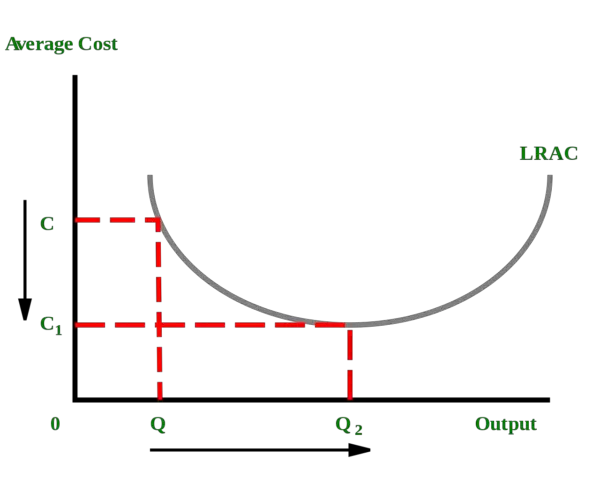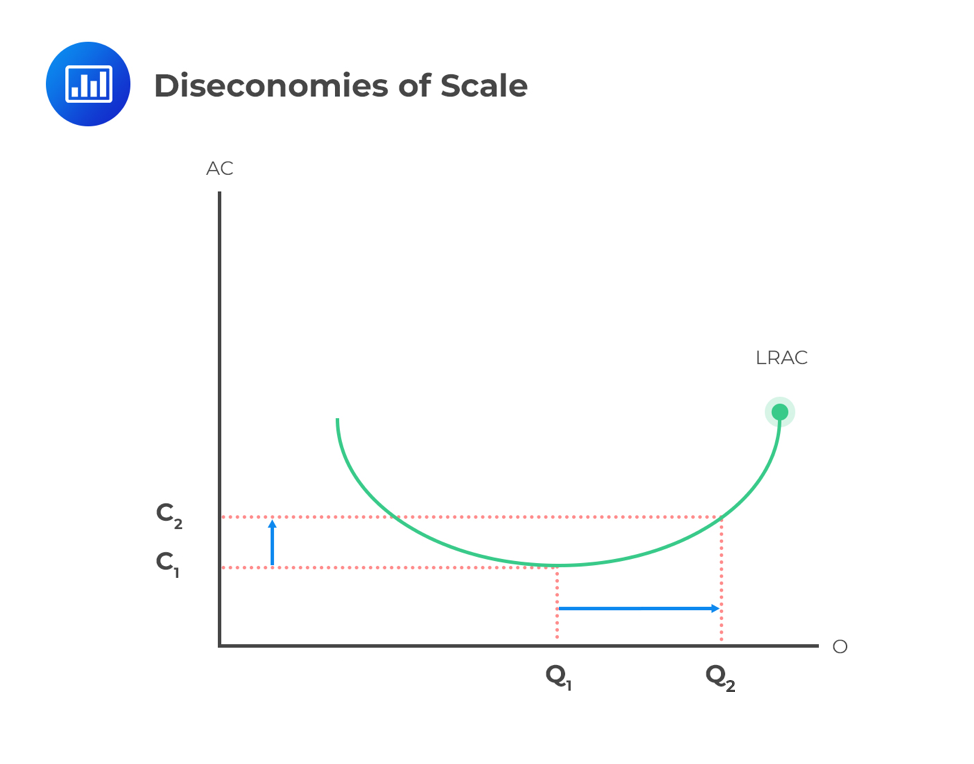Economies and Diseconomies of Scale Explain
Economies of scale happens when a business grow large enough to enable them to lower average cost while diseconomies of scale happens when a. Economies of scale may be defined as a reduction in the firms per unit cost ie.

Economies And Diseconomies Of Scale Explained And Graphed Youtube
Types of Economies of Scale 1.

. Decreasing returns to scale contributes to diseconomies of scale -- LRAC rising thus less output produced per unit. Difference Diseconomies of Scale. Internal Economies of Scale.
Growth brings both advantages and disadvantages to a business. Why the firms long run average total cost curve is u-shaped. Economies of scale exist when long run average total cost decreases as output increases diseconomies of scale occur when long run average total cost increases as output increases and constant returns to scale occur when costs do not change as output increases.
Why the firms short-run marginal cost curve cuts the short-run average variable cost curve at its minimum point. Because of increasing size a firm enjoys certain advantages. Marginal cost curve must intersect the minimum point of the firms average total cost curve.
When a firm doubles its inputs and finds that its output has more than doubled this is known as. For instance a firm may hold a patent over a mass production machine which allows it to lower its average cost of production more than other firms in the industry. It takes place when economies of scale no longer function.
Economies of scale and diseconomies of scale are related concepts and are the exact opposites of one another. In the process of production a firm enjoys several advantages or experience several disadvantages which are either the result of the scale of operation or due to the location of the firm. Diseconomies of scale are when the cost per unit of production Average cost increases because the output sales increases.
Diseconomies of scale defined is the inverse of economies of scale. Diseconomies of scale occur when a business expands so much that the costs per unit increase. Long-run average total cost curve is typically U-shaped.
This refers to economies that are unique to a firm. Economies of scale occurs when the average costs of a firm decrease due to increased output. A purely competitive seller should produce rather than shut down in the short term.
Average cost of production which is associated with the use of large plants to produce a large volume of output. Economies and diseconomies of scale explain. Dthe distinction between fixed and variable costs.
Concept of Economies and Diseconomies of Scale in Managerial Economics. The distinction between fixed and variable costs. Economies and Diseconomies of scale explain a The profit-maximizing level of production b why the firms long run ATC is U- shaped cWhy the firms short-run marginal cost curve cuts the short sun AVC curve at its min point.
Whereas diseconomies of scale refer to the disadvantages that arise due to the expansion of a firms capacity leading to a rise in the average cost of production. Why the firms long-run average total cost curve is U-shaped. On the other hand diseconomies of scale occur when the average costs of a firm increase due to increased output.
Short-run average fixed cost curve declines so long as output increases. Economies and diseconomies of scale explain. Diseconomies of scale occur when.
Economies and diseconomies of scale. When the long run ATC curve rises. But growing size can also bring certain disadvantages.
External Economies of Scale. Economies and diseconomies of scale explain why the. Economies of scale are when the cost per unit of production Average cost decreases because the output sales increases.
This means that as the volume of production increases with an increase in firm size economies of scale yield place to diseconomies of size. The advantages and disadvantages thus experienced are reflected in the cost of production. The profit-maximizing level of production.
It is where prices of an item or product increase as output of the same item or product decreases. Increasing returns to scale contributes to economies of scale -- LRAC falling thus increases in inputs leads to more than proportional increase in output so more output being produced per unit. Economies of scale arise when the cost per unit reduces as more units are produced and diseconomies of scale arise when the cost per unit increases as more units are produced.
:max_bytes(150000):strip_icc()/MinimumEfficientScaleMES2-c9372fffba0a4a1ab4ab0175600afdb6.png)
Minimum Efficient Scale Mes Definition

Economies Of Scale Definition And 8 Examples Boycewire
:max_bytes(150000):strip_icc()/diseconomies_of_scale_final-db85c494049d42aca10deb37e214a013.png)
Diseconomies Of Scale Definition
/diseconomies_of_scale_final-db85c494049d42aca10deb37e214a013.png)
Diseconomies Of Scale Definition

Economies And Diseconomies Of Scales Analystprep Cfa Exam Study Notes

Diseconomies Of Scale Definition 8 Types And 5 Examples Boycewire
0 Response to "Economies and Diseconomies of Scale Explain"
Post a Comment